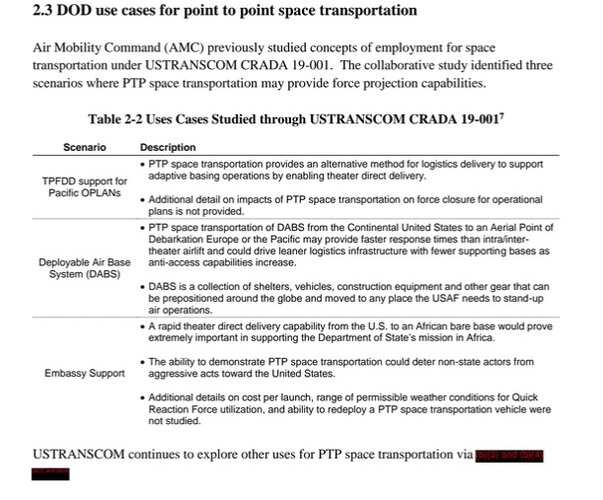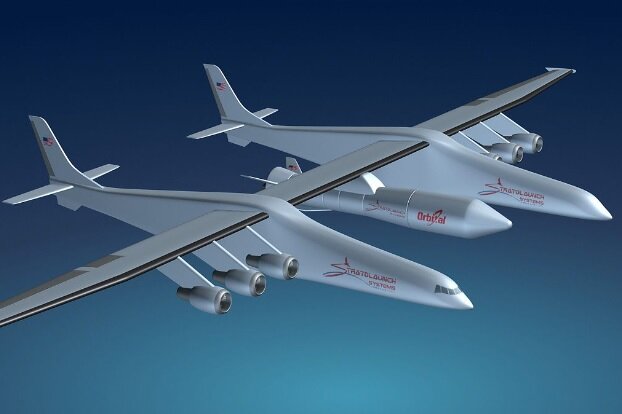You are using an out of date browser. It may not display this or other websites correctly.
You should upgrade or use an alternative browser.
You should upgrade or use an alternative browser.
Small Unit Space Transport and INsertion (SUSTAIN) and HOT EAGLE
- Thread starter XP67_Moonbat
- Start date
martinbayer
ACCESS: Top Secret
- Joined
- 6 January 2009
- Messages
- 3,341
- Reaction score
- 3,811
In my mind I classify those as rainbow systems - colourful and alluring, but no matter how hard you try to move towards them, you'll never actually reach them. Another one of my favorite mental models are cavitation bubbles - concepts that burst on the scene and create a lot of turbulence and noise, but quickly vanish into nothing.I see... SSTO is like thermonuclear fusion, kind of - always a little behind the horizon, but coming soon, they swear.
In my mind I classify those as rainbow systems - colourful and alluring, but no matter how hard you try to move towards them, you'll never actually reach them. Another one of my favorite mental models are cavitation bubbles - concepts that burst on the scene and create a lot of turbulence and noise, but quickly vanish into nothing.I see... SSTO is like thermonuclear fusion, kind of - always a little behind the horizon, but coming soon, they swear.
And it allows you to go faster
Randy
Hafidz Rahman
Just an Aeroweebs...
Hi, I know this is very late but, E-Prime Aerospace have an interesting presentation about their propellant concept for Project Hot Eagle/SUSTAIN program:
Attachments
- Joined
- 29 July 2009
- Messages
- 1,767
- Reaction score
- 2,455
Here's a scenario, "The US launches a large rocket (from an aircraft, launch pad, sub, etc.) that is headed for a nuclear capable country. Their defenses are placed on high alert, ready to start WWIII, when someone nudges the nuclear missile launch controller and suggests that its just 12 Marines with M-4s and some claymores headed to the outskirts of the capital to rescue a political prisoner." Hopefully, they get the message in time.
- Joined
- 29 July 2009
- Messages
- 1,767
- Reaction score
- 2,455

US Army Seeking Rocket-Deployed Quick Reaction Force
The US Army is seeking to acquire a new space transportation capability that would allow soldiers to be launched on rockets.
 thedefensepost.com
thedefensepost.com
Attachments
Scott Kenny
ACCESS: USAP
- Joined
- 15 May 2023
- Messages
- 11,388
- Reaction score
- 13,857
A combat assault landing from space requires the dropship to come in at speeds equal to "the ragged edge of burning up" while semi-random "drunkwalking" jinking to avoid defensive fire. And then firing retro rockets at minimum altitude/maximum burn to land in a controlled crash without killing the occupants.On rocket-based troop transports, I would say that parachutes on approach would be most essential. A hull washdown or icing system would probably be in order, you would think. And a Kevlar belt of some kind would definitely need to be in place.
Audio and visual signatures aside, anyone coming in hot (literally), all rockets blazing and hull still hot from reentry, will have the IR signature of a sun. Those pesky insurgents will have a turkey shoot from their rooftops. Bring your own Stingers and small arms. Not good at all.
Unless the transport makes a landing "in the rear, with the gear", frontline use is not a good idea. No sir'ee.
Basically, think Glider Assault from WW2.
Complete with the desperate need for reinforcements.
Yup. SOCOM types are freaking adrenaline junkies, they'd volunteer to fly a Drop-rocket for fun.The reality:
General Badass announces to a room full of special forces operators:
"We will stuff you in a spaceplane and shoot you across the sky at Mach 18. You will experience 6 g's at takeoff, and variable between 0 g's and 5 g's as you skip across the upper atmosphere. You will abandon the vehicle at 120,000 feet for a HALO jump into enemy territory while wearing an ill-fitting spacesuit made by the lowest bidder, breaking the speed of sound as you fall. You will land in a small compound with four of your fellows where you will rescue American captives from the stupid unteachable monsters who are currently holding them. You will then hold the compound from the onslaught of an expected 3,000 assailants for a minimum of five hours until conventional forces can be flown to support you. We can only send five of you at this time on this harrowing experience which chances are you will not survive. Who wants in?"
The news the following day says that the military had to deploy a combination of sleep gas and ED-209 droids to quell the riot as the operators started beating the hell out of each other for the chance to be first in line.
"This will harrow, yes, your very soul" is an *enticement* to exactly the sort of people we want to rocket across the planet to apply boot to ass for Uncle Sam.
Not if you expect to fly it back out, no.It doesn't matter what the launch vehicle is, flying a spacecraft into a war zone is not workable.
If it's explicitly a one-way trip with a separate system doing the pickup, it's closer to viable.
Again, you need it to come in as fast as the thermal management system can handle all the way down till it scrubs off most of the speed via retro-rocket burn at minimum altitude. Kinda like a Falcon Heavy 1st stage, but faster and with a "crash landing" acceptable.
Go ahead and use a lot of crumple structures to dissipate impact forces, like how cars have crumple zones. Well, more like how race cars have the cockpit tub as the safety structure and everything else can break off to absorb energy instead of the driver.
"Any landing you can walk away from is a good landing."
Trick is dealing with the reentry heat.
Somebody wake up HicksYup. SOCOM types are freaking adrenaline junkies, they'd volunteer to fly a Drop-rocket for fun.
--about that.Not if you expect to fly it back out, no.
There were mini-and microshuttles looked at.
Now I might go with a mini-Buran.
The External Tank has single use 3D print aluminum engines.
The mini-Buran has jet engines that allow a landing, and take off at subsonic speeds.
No air breathing scramjet tech needed. The (sub)orbiter is just another airplane on return. Spent ET draws fire.
I envision something like what the Early Dream Chaser was going to be with the X-34 design.
Scott Kenny
ACCESS: USAP
- Joined
- 15 May 2023
- Messages
- 11,388
- Reaction score
- 13,857
Pretty much.Somebody wake up Hicks
No, the point is that the drop ship needs to come down so fast that there's no time for defenses to engage it. At least no defenses other than lasers. Which means it's not going to make a nice slow descent, or even a Space Shuttle descent at ~24,000fpm. It's coming in like a MARV, finally slowing down below Mach 2 at about 20,000ft, starting the 5gee braking burn at less than 10,000ft, and landing in a ~40gee impact with a crapton of airbags all going off to avoid squishing the troops inside.--about that.
There were mini-and microshuttles looked at.
Now I might go with a mini-Buran.
The External Tank has single use 3D print aluminum engines.
The mini-Buran has jet engines that allow a landing, and take off at subsonic speeds.
No air breathing scramjet tech needed. The (sub)orbiter is just another airplane on return. Spent ET draws fire.
I envision something like what the Early Dream Chaser was going to be with the X-34 design.
- Joined
- 5 May 2007
- Messages
- 1,479
- Reaction score
- 2,846
I'd love to see the safety case for this method of insertion. Because you're going to need a way to keep the self-loading cargo alive in the event that you hit 10,000 feet, and one of the braking motors doesn't light.It's coming in like a MARV, finally slowing down below Mach 2 at about 20,000ft, starting the 5gee braking burn at less than 10,000ft, and landing in a ~40gee impact with a crapton of airbags all going off to avoid squishing the troops inside.
If that happens, you have less than six seconds to do something about it. One of those seconds is going to be occupied with reaction time. So now you're at 8,000 feet, and you need a 6g braking burn. Probably the easiest way to do it is to have multiple throttleable braking motors, so if one doesn't light you can use the others to compensate. Or solids with a crew-rated thrust termination device.
Even if you're willing to take the risk on an operational sortie, you'll still need the ability to carry out training flights that mimic an operational profile. Which will be exceptionally expensive, even if you can figure out a way to refurbish the... lobship? Not like it's being dropped, after all.
- Joined
- 19 February 2007
- Messages
- 1,434
- Reaction score
- 2,668
This delivery vehicle tech was used in Vernor Vinge's "Rainbows End" during a USMC raid on UC San Diego (mostly believable) amid an effective root certificate revocation causing widespread web crashes (pure science fiction! The effective revocation storm, I mean).
Last edited:
- Joined
- 29 July 2009
- Messages
- 1,767
- Reaction score
- 2,455
Scott Kenny
ACCESS: USAP
- Joined
- 15 May 2023
- Messages
- 11,388
- Reaction score
- 13,857
The place I snagged that from has effective "mind-state vector" copying tech, and anyone KIA gets a new body "resurrection" at gov expense, which changes their acceptable-risk profiles greatly. That said, look at the accepted risk profiles for combat parachute drops. 25% or more losses acceptable, 10-20% losses considered normal.I'd love to see the safety case for this method of insertion. Because you're going to need a way to keep the self-loading cargo alive in the event that you hit 10,000 feet, and one of the braking motors doesn't light.
If that happens, you have less than six seconds to do something about it. One of those seconds is going to be occupied with reaction time. So now you're at 8,000 feet, and you need a 6g braking burn. Probably the easiest way to do it is to have multiple throttleable braking motors, so if one doesn't light you can use the others to compensate. Or solids with a crew-rated thrust termination device.
Even if you're willing to take the risk on an operational sortie, you'll still need the ability to carry out training flights that mimic an operational profile. Which will be exceptionally expensive, even if you can figure out a way to refurbish the... lobship? Not like it's being dropped, after all.
But yes, that insertion profile has some scary risks for anyone inside the dropship.
I'm honestly assuming that most of the drop and landing/impact process is going to be fully automated, simply because human reaction times aren't fast enough. And obviously quadruply or more redundant between sensors, computers, retrorockets, ad nauseam.
Rhinocrates
ACCESS: Top Secret
- Joined
- 26 September 2006
- Messages
- 3,013
- Reaction score
- 7,640
What about extraction?
- Joined
- 5 May 2007
- Messages
- 1,479
- Reaction score
- 2,846
Notwithstanding magic dressed up as technology... you might well be willing to accept those risks on an operational insertion. But you need to be able to exercise the capability in a close-to-realistic way, where that level of risk isn't acceptable.That said, look at the accepted risk profiles for combat parachute drops. 25% or more losses acceptable, 10-20% losses considered normal.
Yeah, you'll mitigate the risks for an exercise parachute drop by having higher minima for weather & altitude, having ground parties in place, and all sorts of other things. Not having people shooting at you helps too. I assume you'd exercise this thing by landing it on pre-identified hard surfaces and not doing the evasive manoeuvres with a crew on board.
But when the risk is 'entire crew and vehicle converted to burning crater', demonstrating ALARP is going to be difficult.
Something like Fulton STARS or helicopters. That can be on a longer response time.What about extraction?
Scott Kenny
ACCESS: USAP
- Joined
- 15 May 2023
- Messages
- 11,388
- Reaction score
- 13,857
Market Garden plan, wait for the ground troops to catch up to your location.What about extraction?
Scott Kenny
ACCESS: USAP
- Joined
- 15 May 2023
- Messages
- 11,388
- Reaction score
- 13,857
As Low As Reasonably Practicable?Notwithstanding magic dressed up as technology... you might well be willing to accept those risks on an operational insertion. But you need to be able to exercise the capability in a close-to-realistic way, where that level of risk isn't acceptable.
Yeah, you'll mitigate the risks for an exercise parachute drop by having higher minima for weather & altitude, having ground parties in place, and all sorts of other things. Not having people shooting at you helps too. I assume you'd exercise this thing by landing it on pre-identified hard surfaces and not doing the evasive manoeuvres with a crew on board.
But when the risk is 'entire crew and vehicle converted to burning crater', demonstrating ALARP is going to be difficult.
Yes, getting all the bits to work together to allow troops to arrive might well take until we can develop a way to copy all the information that makes your consciousness you to a new media. Whether Altered Carbon or otherwise.
martinbayer
ACCESS: Top Secret
- Joined
- 6 January 2009
- Messages
- 3,341
- Reaction score
- 3,811
Think of it as parachutists on steroids.What about extraction?
Why Buran? Why is everything you propose is Soviet? X-37 is a better vehicle. Buran jet engines were not for the space vehicle version.Somebody wake up Hicks
--about that.
There were mini-and microshuttles looked at.
Now I might go with a mini-Buran.
The External Tank has single use 3D print aluminum engines.
The mini-Buran has jet engines that allow a landing, and take off at subsonic speeds.
No air breathing scramjet tech needed. The (sub)orbiter is just another airplane on return. Spent ET draws fire.
I envision something like what the Early Dream Chaser was going to be with the X-34 design.
and they are unnecessaryThe Analog's jet weren't space rated no--the OK-92 variants would have been.
Similar threads
-
-
-
Space: 1959 "Space Age" concept poster on cardboard
- Started by Triton
- Replies: 22
-
Rumsfeld's Alternative Fleet Architecture Design and the Weapon Ship/Combat Systems Ship (X-WPS)
- Started by that_person
- Replies: 10
-
Airborne megawatt class free-electron laser for defense and security
- Started by Lt-Col A Tack
- Replies: 8



